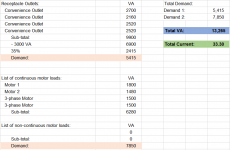Alaktrical_Gingineer
adult cam girls for chat
- Location
- Usa
- Occupation
- live girls online privateladyescorts.com
Hi! May I ask how you do your Schedule of Loads here? I want to verify if we are doing the same way as you do.
Let us make an example. Suppose I have 230V, Three Phase System. Can you show how much is your 3-phase feeder current (Yellow Highlight) for this specific panel? I've got 50.24 Amperes

For fun and learning only. I am planning to ask a follow-up question after this.
Cheers and keep safe!
Let us make an example. Suppose I have 230V, Three Phase System. Can you show how much is your 3-phase feeder current (Yellow Highlight) for this specific panel? I've got 50.24 Amperes

For fun and learning only. I am planning to ask a follow-up question after this.
Cheers and keep safe!


